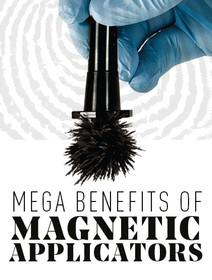Posted by EL on 3rd Jun 2019
Magnets and Fingerprints
With so many fingerprinting products on the market to choose from, it can be an overwhelming choice when faced with the task of pulling usable fingerprints from a piece of evidence.
Today, we will be discussing magnetic applicators: in what scenarios and on what pieces of evidence are they best used?
Magnetic applicators are a great way to dust an area or piece of evidence for fingerprints without over powdering the area in question. An example of this would be a foil chip bag that has been wadded up and has deep groves that need to be examined for prints, or a label on a water or soda bottle that is very slick, on top of the textured surface of the bottle. Also, a very delicate piece of evidence that could be broken or destroyed with the application of too much pressure.
The applicators allow you to lightly dust over an area with greater control over the amount of powder touching the fingerprint. Clean-up is also made easier, as you can unload the applicator and go over the area to pick up excess powder.
Using the applicator is quite simple. Magnetic fingerprint powder is needed to pair with the applicator and it comes in a variety of different colors. There are also a variety of applicator sizes, depending on the size of the area you are needing to fingerprint.

Standard magnetic applicators resemble pens with a large end on one side and are best suited for small to medium areas of processing.

The Tex Magnetic Applicator has individually wrapped, disposable shields that prevent cross contamination due to the fact that once the area is processed, the shield can be disposed of and a new one placed on the applicator.

The Zenith Magnetic Applicator is larger and more highly magnetic which makes it capable of carrying over 3 times the powder of standard wands. It has a unique pentagon shaped head that ensures the tip doesn’t touch the items being processed. It features a spring-loaded ejector end for easy release of powder and the head is also removable for decontamination washes between scenes.
The applicator has magnets inside of it that attract the powder. So, to use the applicator, first make sure the end of the applicator is clean. Then, dip the applicator into a small amount of magnetic powder until a “powder brush” is formed and you can no longer see the head of the applicator at the very tip.
POWDER BRUSH
When dusting the area for fingerprints, it is useful to use a flashlight or some other source of light from an angle, to locate potential fingerprints that you will want to develop with the powder.
Once the applicator is loaded with powder, lightly touch the tip of the powder to the area and slowly brush it back and forth in a brushing motion against the surface until ridge detail is seen.
If too much pressure is applied, the “powder brush” can be flattened. The applicator itself should never touch or scrape against the item being processed.
FLATTENED POWDER BRUSH
If the powder on the end of the applicator becomes flattened, the plunger on the opposite end of the applicator should be pulled, releasing the powder from the tip. Then, the applicator can be reloaded. If there is a concern for cross contamination, the powder can be discarded after being released from the applicator and new powder applied.
If some of the powder becomes dislodged from the applicator during processing, it can be removed by an empty applicator being hovering over the loose powder.
Magnetic applicators are not ideal for vertical surfaces, as the powder may not stay adhered to the applicator at that angle.
The developed fingerprint can then be lifted in whatever way practical, such as with fingerprint tape, gel or hinge lifts, etc
REFERENCES:
Lee and Gaensslen's Advances in Fingerprint Technology, Third Edition, Robert Ramotowski
 ABOUT THE AUTHOR
ABOUT THE AUTHOR
Emily Lewey is a former IAI certified Crime Scene Investigator. She obtained her associate’s degree in Law Enforcement and her bachelor’s degree in Criminal Justice Administration with a minor in Crime Scene Investigation from Missouri Southern State University. Emily worked for the Lee’s Summit, MO PD as their first and only CSI for 4 years, then for the Kansas City, MO PD Crime Lab for 1 and a half years before coming to Arrowhead Forensics. She worked a wide variety of scenes ranging from property crimes to homicides and is proficient in a variety of processing techniques. She continues to stay educated in the ever-changing world of forensics and crime scene work.


